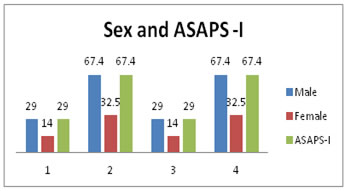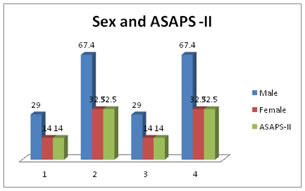Official Journals By StatPerson Publication
|
Table of Content - Volume 11 Issue 3 -September 2019
Efficacy of ropivacaine alone and ropivacaine with dexamethasone in supraclavicular brachial plexus block - A comparative study in north Karnataka population
Mahindra B Kalashetty1, Geetha S Hasaraddi2*
1Assistant Professor, Department of Anesthesiology, S Nijalingappa Medical College, HSK-(HanagalShreeKumareshwar), Hospital and Research Centre Bagalkot. 2Assistant Professor, Department of Anesthesiology, Navodaya Medical College Hospital and Research Centre, Raichur. Email: mahindra2936@gmail.com
Abstract Background: Mixing of various adjutants have been tried with local anesthetic in attempt to prolong anesthesia from peripheral nerve blocks but have met with inconclusive success. Hence dexamethasone mixed with Ropivacaine and compared the efficacy with ropivacaine alone. Method: out of 86 patients 43 group A- patients was administrated with 28ml of 0.5% injection Ropivacaine alone. In B group 43 patients was administered with 28ml of 0.5% of Ropivacaine with 2ml of 8 mg Dexamethasone Results: Both groups have 29(67.4%) male 14(32.5%) females, 29(67.4%) ASA grade-I, 14(32.5%) ASA grade-II. In the comparative study except value of duration, onset of, sensory block and motor block. Duration of sensory block and motor block had significant P value (P<0.01). Conclusion: This empirical study proved that combination dosage of Ropivacaine and Dexamethasone significantly shortens the onset and prolonged the duration of sensory and motor blocks in upper limb surgery. Key Words: Supra-clavicular,upper limb, dexamethasone, Ropivacaine, ASA grade.
INTRODUCTION The brachial plexus block for upper limb surgery has proved to be safer and effective method of regional anesthesia. But it is a common observation that surgeries on upper limb are still performed under general anesthesia despite unanimous consensus towards regional anesthesia due to one or the other reasons1. Supra clavicular approach is the easiest and most consistent method for anesthesia and post operative pain management in surgery below the shoulder joint (arm and forearm) Local anesthetics alone for supra-clavicular brachial plexus block provide good operative conditions but have shorter duration of post operative analgesia. This problem can be overcome by using long acting local anesthetics like Bupivacaine, ropivacaine or by using adjuvant in regional anesthesia. The adjuvant added to brachial plexus block should prolong the analgesia without systemic side effects, prolong motor block and should also reduce the total dose of local anesthetics2,3. It was reported that several adjuvant drugs have proved more effect on prolong motor block and analgesia on contrary they are inconclusive or associated with side effects4,5. Hence attempt was made to administer steroid because steroids have powerful anti-inflammatory and analgesic property. They relive pain by reducing inflammation and blocking transmission of nociceptive c-fibres by suppressing ectopic neural discharges6. Among the steroids Dexamethosone is a very potent, highly selective glucocorticoid.
MATERIAL AND METHODS 86 patients aged between 19 to 60 years admitted at Shri B M. Patil Medical College Hospital Bijapur-586101 Karnataka at Orthopedic surgery department for arm and forearm surgeries were studied. Inclusive criteria- The patients of ASA grade –I and II. Two groups of patients A and B were 43 selected by lottery method, after the fitness permission by the physician. A group patients was administrated with 28ml of 0.5% of injection Ropivacaiane alone +2ml of saline and group B was given 28 ml of injection Ropivacaine with 2 ml of 8 mg dexamethasone Both group of the patients were pre-mediated with I.V 1 mg Midazolam, 20 minutes before giving the block. The patients were connected with monitor to record heart rate (HR) non- invasive measurement of systolic Blood pressure (SBP), diastolic blood pressure (DBP), continuous ECG(Electro cardiogram) monitoring and hemoglobin oxygen saturation (SPO2).The base line systolic and diastolic BP and heart rate were recorded. The site of injection was shaved and disinfected before administration. The injection site was infiltrated with 1ml of lidocaine 2% sub-cutaneaously. The location end point was a distal motor response with on output lower than 0.6 mA. During injection, negative aspiration was performed after every 6.5 to 7.0ml to avoid intravascular injection. Sensory and motor block with monitoring of vitals was determined on every 5 minutes in first 30 minute and then every 15 minutes during first hour followed by 2nd hourly for 24 hours. Any hypersensitivity reaction for the drugs. Evidence of pnemothorax, any other adverse events was also monitored. To evaluate the duration of sensory block and motor block, the patients were asked to inform the time when incisional discomfort as a sensation of pain begin and also the time sensation of pain returned to the shoulder. In the post- operative period. When the patients complained of pain at the operative site Injection Diclofenac 75 mg In was given patients were followed up for 24 hours for any side effects. Duration of study was about 2 years (April 2014 to May02016) Exclusion criteria: The patients below 18 year and more than 60 years , ASA grade III,IV or V patients, Patients using antidepressants antipsychotics sensitive to amide local anesthetics or history of hypersensitive to Dexamethasone, were excluded from the study. Statistical analysis Onset of sensory block and motor block (in minutes),duration of sensory and motor block in both groups was compared. The duration of surgery in both groups (in minutes ) was also compared. The statistical analysis was done in SPSS soft ware 2007computer
OBSERVATION AND RESULTS Table-1Group A – had 29(67.4%) male and 14(32.5%) females. ASA grade-I had 29(67.4%) patients and grade-II had 14(32.5%) patients Group-B had also same number of six and same ASA grade I,II were observed. Table-2Duration of surgery(in minutes) mean value 103(SD±31.0) in group A 101.1(SD±0.34)in group B t test value was 0.34 and P value was insignificant (P>0.05) Onset of sensory block (in minutes) in group A- mean value was 17.12 (SD±2.64) in group B 15.10 (SD±1.48) ‘t’ test value 2.27 and P Value was significant (P<0.01) Onset of motor block (in minutes) 15.84(SD±2.64) in group A, 1960 (SD±2.60)in group B’t’ test value was 6.63 P value was significant (P<0.05) . Duration of sensory block (in minutes) 608.72(SD±31.03) in group A, 1120.54(SD±24.30) ‘t’ test value was 85.03 P value was significant (P<0.05). Duration of motor block (in minutes) 540.40(SD±26.32) in group A 828.30(SD± 25.83) ‘t’ test value 51.19 P value was significant (P<0.05)
Table 1: Comparison of Sex and ASAPS in both groups (Total No of patients -86)
Table 2: Comparison of duration and efficacy in both groups (Total No of patients-86)
The comparison between Group A and Group B, Parameters have significant P values (P<0.05) except duration of surgery.
DISCUSSION In the present study there was a comparison of efficacy of Ropivacaine alone and Ropivacaine+ dexamethasone. In the comparison of sexes and grade of ASA both groups had same number of sex and ASA grades- 29 (67.4%) male, 14(32.4%) females 29(67.4%) ASA grade I 14(32.5%) grade-II (Table-1) In comparison of duration and efficiency in both groups. Duration of surgery (minutes) in group A mean value was 103.52(SD±31.0) and ‘t’ test was 0.34 and insignificant P value (P>0.05). In the onset of sensory block (in minutes) mean value of group A was 17.12(SD±1.57) in group B 15.10 (SD±1.48)’t’ test was 2.27 and P value was significant (P<0.01). onset of motor block (in minutes) mean value of group A was 15.85(SD±2.64) group B was 19.60(SD±2.60) ‘t’ test was 6.63 and P value was significant (P<0.01. Duration of sensory block mean value group A was 608.72(SD±31.03) group B was 1120.54 (SD±24.39)’t’ test was 85.03 P value was significant (P<0.01). in the duration of motor block (in minutes) mean value in group A was 540.4(SD±26.32), group B was 828.30(SD±25.83) ‘t’ test value was 51.19 and P value was significant (P<0.01)( Table-2). These finding were more or less in agreement with previous studies7,8,9. This combination of Ropivacaine with dexamethasone has affection produced earlier onset of action and significantly prolonged the duration of analgesia. As well10. This effect is mediated via glucose corticoids receptor. When dexamethasone alone used in regional block, the blockade is not produced. Dexamethasone might bring about this effect by altering the function of potassium channel in excitable cells11. Onset of sensory and motor in group B has earlier onset than group A may be due to synergistic action of Dexamethasone with local anesthetics on blocking nerve fibres12. It was also reported that, according to traditional theory of steroid action, steroids bind to intra cellular receptor and modulate nuclear transcription. It was also observed that, steroids producers analgesia by blocking transmission in nociceptivec- fibers and suppressing ectopic neuronal diseases13. Moreover the concern surrounding the “off label” use of perineural adjuvants14. The safety profile of dexamethasone is promising. None of our patients complained about neurotoxicity or any other complaints attributed to dexamethasone.
SUMMARY AND CONCLUSION The present comparative study, the administration of Dexamethasone with Ropivacaine as an adjuvant in supraclavicular brachial plexus significantly prolonged the duration of post operative analgesia, sensory and motor block in patients undergoing upper limb surgeries which lasted much longer than that produced by local anesthetic alone. It was well tolerated and cost- effective method without occurrence of remarkable adverse effects. But this study demands further, patho- physiological, neuro-muscular, pharmacological, genetic study because the mechanism of analgesia induced by cartico- steroids is still un-clear.
REFERENCES
|
|
|||||||||||||||||||||||||||||||||||||||||||||||||||||||||||||
 Home
Home


